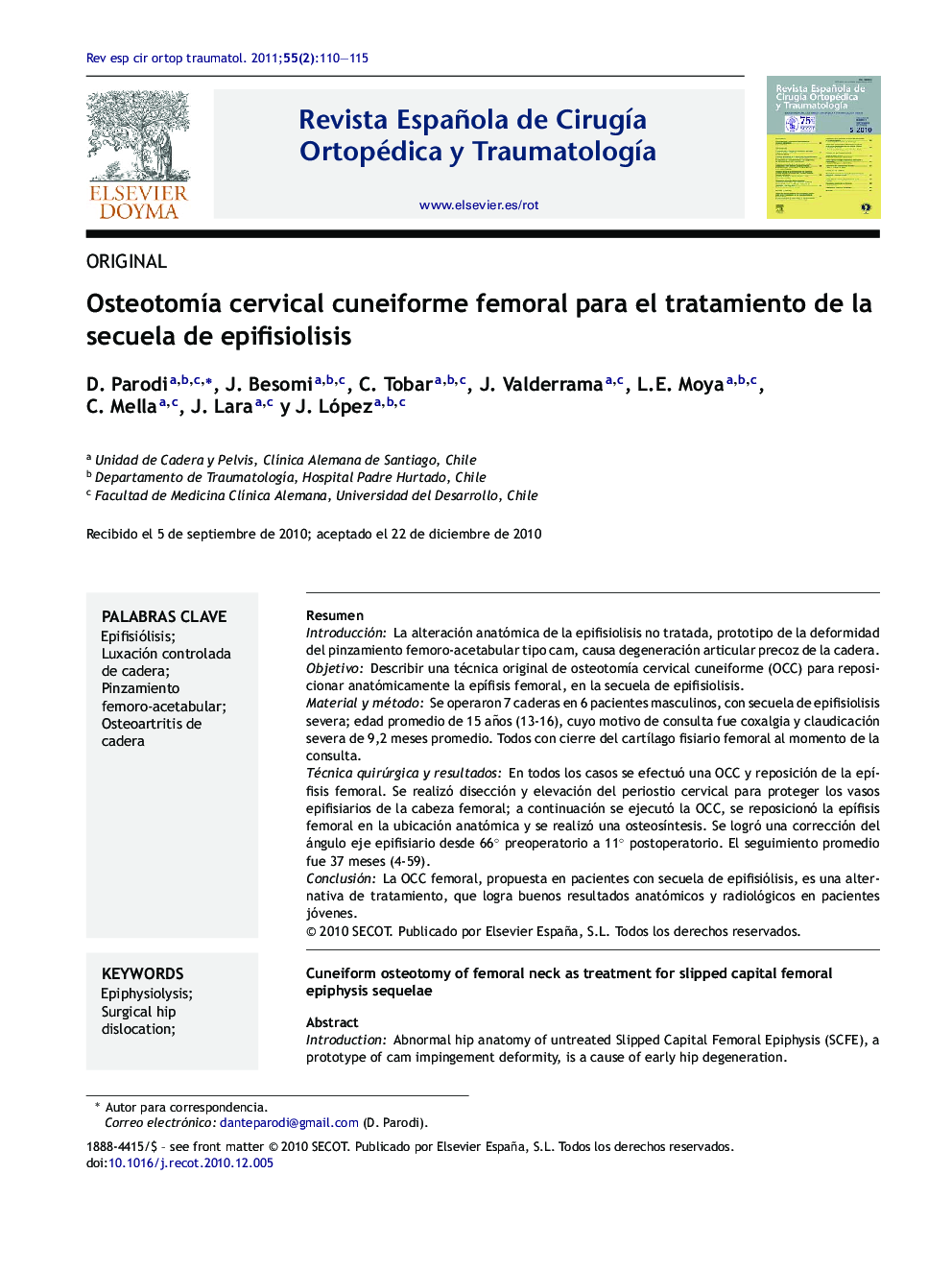| کد مقاله | کد نشریه | سال انتشار | مقاله انگلیسی | نسخه تمام متن |
|---|---|---|---|---|
| 4086630 | 1267965 | 2011 | 6 صفحه PDF | دانلود رایگان |

ResumenIntroducciónLa alteración anatómica de la epifisiolisis no tratada, prototipo de la deformidad del pinzamiento femoro-acetabular tipo cam, causa degeneración articular precoz de la cadera.ObjetivoDescribir una técnica original de osteotomía cervical cuneiforme (OCC) para reposicionar anatómicamente la epífisis femoral, en la secuela de epifisiolisis.Material y métodoSe operaron 7 caderas en 6 pacientes masculinos, con secuela de epifisiolisis severa; edad promedio de 15 años (13-16), cuyo motivo de consulta fue coxalgia y claudicación severa de 9,2 meses promedio. Todos con cierre del cartílago fisiario femoral al momento de la consulta.Técnica quirúrgica y resultadosEn todos los casos se efectuó una OCC y reposición de la epífisis femoral. Se realizó disección y elevación del periostio cervical para proteger los vasos epifisiarios de la cabeza femoral; a continuación se ejecutó la OCC, se reposicionó la epífisis femoral en la ubicación anatómica y se realizó una osteosíntesis. Se logró una corrección del ángulo eje epifisiario desde 66° preoperatorio a 11° postoperatorio. El seguimiento promedio fue 37 meses (4-59).ConclusiónLa OCC femoral, propuesta en pacientes con secuela de epifisiólisis, es una alternativa de tratamiento, que logra buenos resultados anatómicos y radiológicos en pacientes jóvenes.
IntroductionAbnormal hip anatomy of untreated Slipped Capital Femoral Epiphysis (SCFE), a prototype of cam impingement deformity, is a cause of early hip degeneration.ObjectiveTo describe an original technique of cuneiform osteotomy of the femoral neck to relocate femoral epiphysis in patients with sequelae of SCFE.MethodsSeven hips in 6 male patients with sequelae of severe SCFE, with a mean age of 15 years (13-16), and with a mean of 9.2 months of hip pain and severe limp, were treated. All of the cases had closed growth cartilage at the time of consultation.Surgical technique and resultsIn all cases we performed a cuneiform osteotomy of the femoral neck with relocation of epiphysis. A dissection and elevation of cervical periosteum to protect the epiphyseal vessels of the femoral head was performed. Then, the cuneiform osteotomy of the femoral neck was performed with relocation of the femoral epiphysis to the anatomical position and osteosynthesis. We achieved an epiphyseal-shaft angle correction from 66° preoperative to 11° postoperative. The mean follow up was 37 months (4-59).ConclusionCuneiform osteotomy of the femoral neck proposed in patients with sequelae of SCFE is an alternative treatment that achieves good anatomical and imaging results in young patients.
Journal: Revista Española de Cirugía Ortopédica y Traumatología - Volume 55, Issue 2, March–April 2011, Pages 110–115